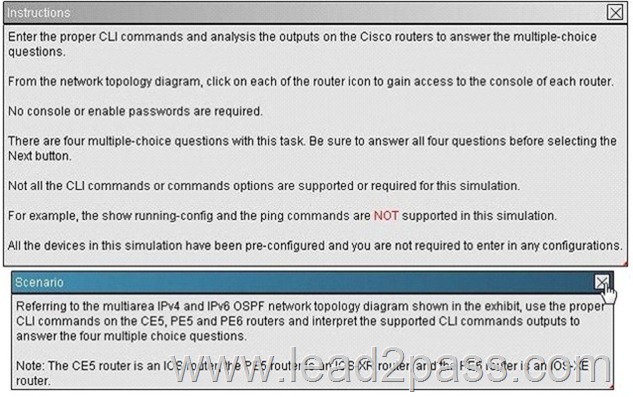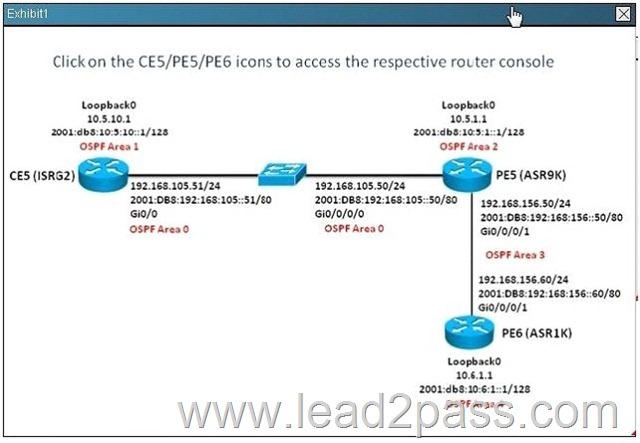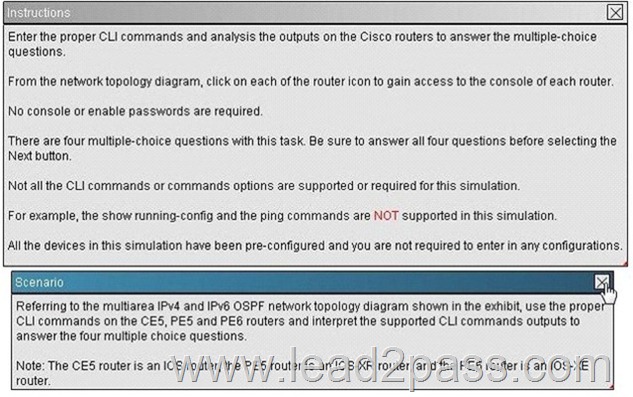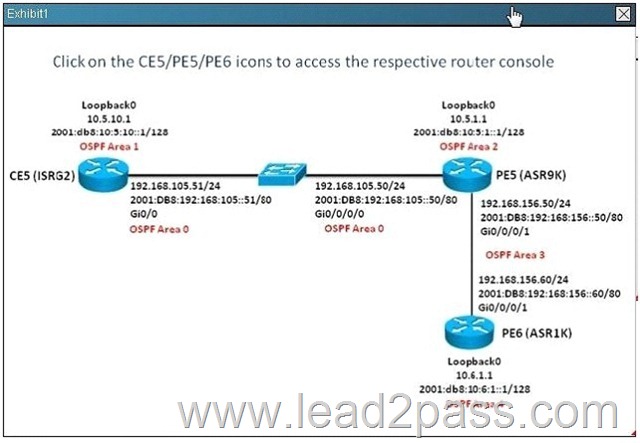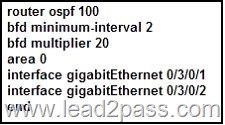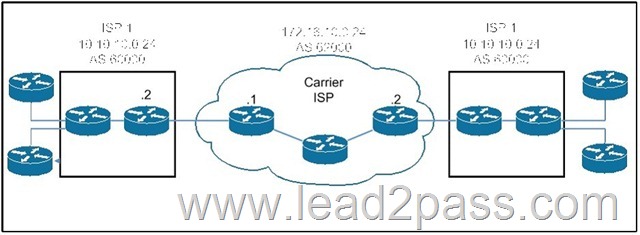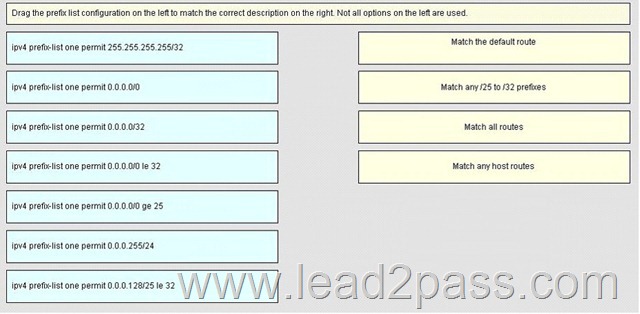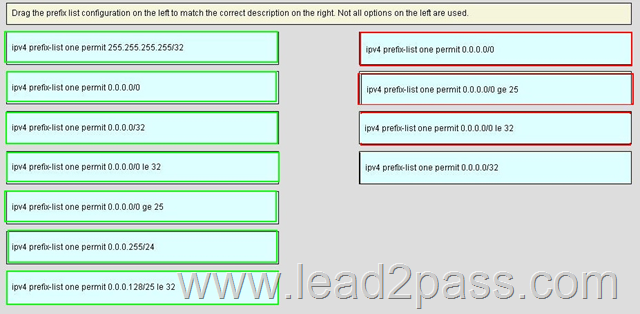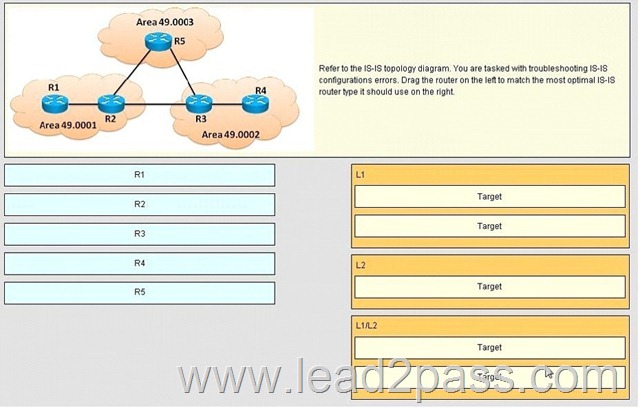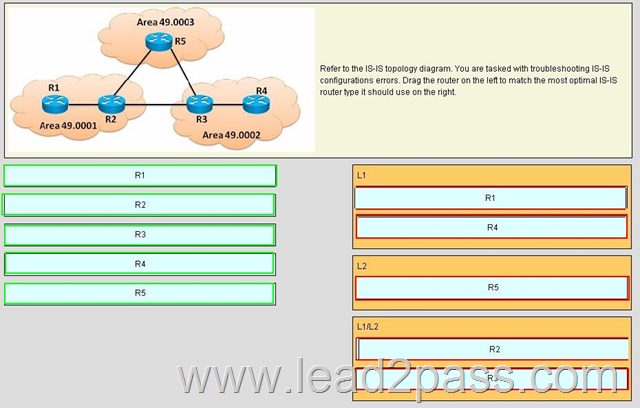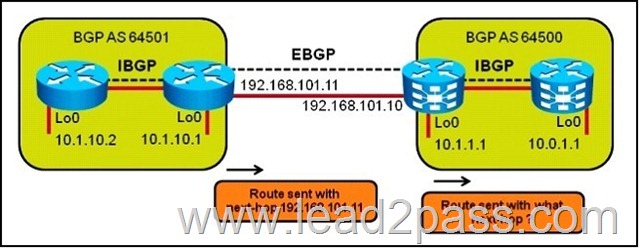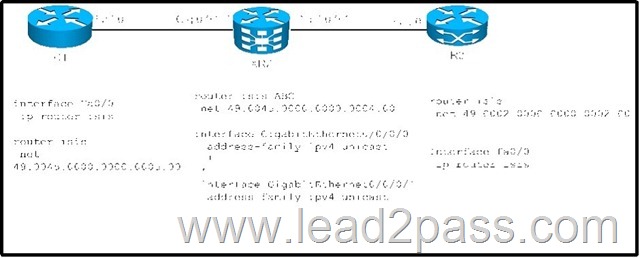2016 December Cisco Official New Released 642-883 Dumps in Lead2pass.com!
100% Free Download! 100% Pass Guaranteed!
Test your preparation for Cisco 642-883 with these actual 642-883 new questions below. Exam questions are a sure method to validate one’s preparation for actual certification exam.
Following questions and answers are all new published by Cisco Official Exam Center: http://www.lead2pass.com/642-883.html
QUESTION 41
Hotspot Question
On the PE5 router, there are how many IPv4 and IPv6 OSPF neighbors and how many IPv4 OSPF interfaces? (Choose three)
A. Two ipv4 ospf neighbors
B. Three ipv4 ospf neighbors
C. Two ipv6 ospf neighbors
D. Three ipv6 ospf neighbors
E. Three ipv4 ospf interfaces
F. Four ipv4 ospf interfaces
Answer: AEF
Explanation:
# show ip ospf neighbor
# show ipv6 ospf neighbor
QUESTION 42
Hotspot Question
How many total OSPF virtual links are configured in this multiarea OSPF network which supports both OSPFv2 and OSPFv3 for IPv4 and IPv6 routing?
A. 1
B. 2
C. 3
D. 4
Answer: B
Explanation:
#Show running-config | include virtual – check how many router having “virtual ” entry
QUESTION 43
Which high-availability routing feature requires the neighbor router to support the graceful restart capability?
A. BFD
B. NSR
C. NSF
D. MTR
Answer: C
Explanation:
On Cisco IOS XR software, NSF minimizes the amount of time a network is unavailable to its users following a route processor (RP) failover. The main objective of NSF is to continue forwarding IP packets and perform a graceful restart following an RP failover.
When a router restarts, all routing peers of that device usually detect that the device went down and then came back up. This transition results in what is called a routing flap, which could spread across multiple routing domains. Routing flaps caused by routing restarts create routing instabilities, which are detrimental to the overall network performance. NSF helps to suppress routing flaps in NSF-aware devices, thus reducing network instability.
NSF allows for the forwarding of data packets to continue along known routes while the routing protocol information is being restored following an RP failover. When the NSF feature is configured, peer networking devices do not experience routing flaps. Data traffic is forwarded through intelligent line cards while the standby RP assumes control from the failed active RP during a failover. The ability of line cards to remain up through a failover and to be kept current with the Forwarding Information Base (FIB) on the active RP is key to NSF operation.
When the Cisco IOS XR router running IS-IS routing performs an RP failover, the router must perform two tasks to resynchronize its link-state database with its IS-IS neighbors. First, it must relearn the available IS-IS neighbors on the network without causing a reset of the neighbor relationship. Second, it must reacquire the contents of the link-state database for the network.
The IS-IS NSF feature offers two options when configuring NSF:
IETF NSF
Cisco NSF
If neighbor routers on a network segment are NSF aware, meaning that neighbor routers are running a software version that supports the IETF Internet draft for router restartability, they assist an IETF NSF router that is restarting. With IETF NSF, neighbor routers provide adjacency and link-state information to help rebuild the routing information following a failover.
In Cisco IOS XR software, Cisco NSF checkpoints (stores persistently) all the state necessary to recover from a restart without requiring any special cooperation from neighboring routers. The state is recovered from the neighboring routers, but only using the standard features of the IS-IS routing protocol. This capability makes Cisco NSF suitable for use in networks in which other routers have not used the IETF standard implementation of NSF
QUESTION 44
In comparing IS-IS with OSPF, a Level-1-2 IS-IS router is similar to which kind of OSPF router?
A. ASBR on a normal OSPF area
B. ASBR on NSSA
C. ABR on totally stubby OSPF area
D. ABR on stubby OSPF area
E. ABR on a normal OSPF area
Answer: C
QUESTION 45
What is recursive lookup in BGP and how does it work?
A. The router looks up the EBGP route and the EBGP next hop to reach a destination in the remote AS. Then the router looks up the route to reach the EBGP next hop using the IBGP.
B. The router looks up the IBGP route and the IBGP next hop to reach a destination in the remote AS. Then the router looks up the route to reach the IBGP next hop using the EBGP.
C. The router looks up the BGP route and the BGP next hop to reach a destination in the remote AS. Then the router looks up the route to reach the BGP next hop using the IGP.
D. The router looks up the route and the next hop to reach a destination in the remote AS using the IGP. Then the router looks up the route to reach the next hop using BGP.
E. The router perform three routing lookups to determine the route to reach a destination in the remote AS. The first lookup is done using EBGP, the second lookup is done using IBGP, and the third lookup is done using the IGP.
Answer: C
Explanation:
A few different approaches are available to deal with iBGP and synchronization. We may turn on the synchronization option on our routers and wait for the IGP to have a route for the destination before it’s advertised to peers. Another option is to simply use a full mesh, so that iBGP convergence isn’t an issue.
Clearly that isn’t going to happen when a network’s core needs to scale: it will implement something like reflectors that cause iBGP’s full mesh to be broken. The real alternative, if you don’t enable synchronization, is to use route recursion. A recursive route lookup uses the BGP next-hop attribute to actually make a different route lookup. The IGP can use the destination network instead of the AS-path to determine where it gets sent. Even if the iBGP hasn’t converged, the routers will still know how to get to that network, since it will exist in the router it was advertised from, who will know the next-hop.
QUESTION 46
A static default route has been inserted into the configuration of a Cisco IOS XE router. Which option redistributes the route into the local OSPF process?
A. router ospf 1
redistribute static subnets
B. router ospf 1
redistribute static
C. router ospf 1
redistribute static subnets
default-information originate always
D. router ospf 1
network 0.0.0.0 area 0
redistribute static subnets
Answer: C
QUESTION 47
What is function of the RP/0/RSP0/CPU0:PE1(config-ospf)#distance Cisco IOS-XR command?
A. To modify the administrative distance of the OSPF routes
B. To modify the default seed metric of the OSPF external routes
C. To modify the OSPF default reference bandwidth
D. To modify the OSPF cost
Answer: A
Explanation:
http://www.cisco.com/en/US/docs/ios_xr_sw/iosxr_r3.8/routing/command/reference/rr38osp
F.pdf
QUESTION 48
Refer to the exhibit.
Which Cisco IOS XR configuration is missing to complete the configuration task of enabling BFD with only the OSPF peer over the gi0/3/0/1 interface in area 0?
A. bfd fast-detect also needs to be enabled globally under router ospf 100.
RP/0/RSP0/CPU0:P1(config-ospf)#bfd fast-detect
B. bfd fast-detect also needs to be enabled for the OSPF area under area 0.
RP/0/RSP0/CPU0:P1(config-ospf-ar)#bfd fast-detect
C. bfd fast-detect also needs to be enabled for the OSPF interface under area 0 interface gi0/3/0/1.
RP/0/RSP0/CPU0:P1(config-ospf-ar-if)#bfd fast-detect
D. bfd fast-detect also needs to be enabled globally on the router.
RP/0/RSP0/CPU0:P1(config#bfd fast-detect
E. bfd fast-detect also needs to be enabled on the gi0/3/0/1 interface under interface gi0/3/0/1.
RP/0/RSP0/CPU0:P1(config-if)#bfd fast-detect
Answer: C
Explanation:
bfd fast-detect
To enable Bidirectional Forwarding Detection (BFD) to detect failures in the path between adjacent forwarding engines, use the bfd fast-detect command in the appropriate configuration mode. To return the software to the default state in which BFD is not enabled, use the no form of this command.
bfd fast-detect [disable | ipv4]
no bfd fast-detect
QUESTION 49
Which configuration is used when matching a prefix-list <name> in a route map?
A. match ip address prefix-list mylist
B. match ip address mylist
C. match ip next-hop mylist
D. ip local-policy route-map mylist
E. ip-policy route-map mylist
Answer: A
QUESTION 50
Refer to the exhibit.
Routers B and C in transit AS 200 are the exit points toward AS 100 and AS 300. Router B is running Cisco IOS XR and Router C IOS XE. Internally, AS 200 runs OPSF only for internal routing. Which two methods can an engineer use to ensure proper reachability between AS 100 and AS 300 for the needed routes? (Choose two.)
A. Router B:
router ospf 200
redistribute bgp 200 tag 20
router bgp 200
address-family ipv4 unicast
redistribute ospf 200 metric-type 2
B. Router B:
router ospf 200
redistribute bgp 200
router bgp 200
address-family ipv4 unicast
redistribute ospf 200
C. Router C:
router ospf 200
redistribute bgp 200 metric-type 1 subnets tag 200 router bgp 200
address-family ipv4
redistribute ospf 200
D. Router C:
router ospf 200
redistribute bgp 200 metric-type 1 subnets tag 200 router bgp 200
address-family ipv4
redistribute ospf 200 match external 2
E. Router C:
router ospf 200
redistribute bgp 200 metric-type 1 subnets tag 200 router bgp 200
address-family ipv4
redistribute ospf 200 route-map match-tag match external route-map match-tag deny 10
match tag 200
Answer: AD
QUESTION 51
Drag and Drop Question
Answer:
QUESTION 52
Drag and Drop Question
Answer:
QUESTION 53
Which three statements are true regarding the OSPF router ID? (Choose three.)
A. The OSPF routing process chooses a router ID for itself when it starts up.
B. The router-id command is the preferred procedure to set the router ID.
C. If a loopback interface is configured, its address will always be preferred as the router ID over any other methods.
D. After the router ID is set, it does not change, even if the interface that the router is using for the router ID goes down. The router ID changes only if the router reloads or if the OSPF routing process restarts.
E. In OSPF version 3, the OSPF router ID uses a 128-bit number.
Answer: ABD
QUESTION 54
When redistributing EIGRP routes into OSPF as type E2 external OSPF routes, what is the default OSPF seed metric?
A. Infinite
B. 0
C. 1
D. 10
E. 20
Answer: E
QUESTION 55
Which reserved AS number or range of numbers is used for backward compatibility between old BGP peers using 16-bit AS number and new BGP peers using 32-bit AS number?
A. AS 65001 to 65535
B. AS 65512 to 65535
C. AS 12345
D. AS 23456
E. AS 64001
Answer: D
Explanation:
http://www.cisco.com/en/US/prod/collateral/iosswrel/ps6537/ps6554/ps6599/4byte_asnios.
pdf
New Reserved AS#
AS_TRANS = AS #23456
2-byte placeholder for a 4-byte AS number
Used for backward compatibility between OLD and NEW BGP speakers
QUESTION 56
A network engineer wants to set the local preference to 100 for the specific BGP community sets of 100:1, 101:1, and 102:1. Which option can the engineer use to implement this through RPL, where the BGP community set list is made by the name of lowpri-communities?
A. route-policy ch-pref
if community matches lowpri-communities then
set local-preference 100
endif
end-policy
B. route-policy ch-pref
if community eq lowpri-communities then
set local-preference 100
endif
end-policy
C. route-policy ch-pref
if community matches-any lowpri-communities then
set local-preference 100
endif
end-policy
D. route-policy ch-pref
if community neq lowpri-communities then
set local-preference 100
endif
end-policy
Answer: C
QUESTION 57
In Cisco IOS and Cisco IOS XE Software images, when redistributing routes from other routing protocols into OSPF, what is a common reason why some of the routes might not be redistributed into OSPF?
A. The OSPF external metric type (E1 or E2) is not defined.
B. The OSPF seed metric is not defined.
C. The OSPF level (Level 1, Level 2, or Level-1-2) to which the routes will be redistributed into is not defined.
D. The subnets option in the redistribute command is missing.
Answer: D
QUESTION 58
Refer to the network diagram in the exhibit.
Assuming the IBGP session within AS 64500 was established using the loopback 0 interface between the two routers, by default, what will be the next hop of the routes from AS 64501 when the routes appear on the router running IBGP only in AS 64500?
A. 192.168.101.11
B. 192.168.101.10
C. 10.1.1.1
D. 10.0.1.1
E. 10.1.10.1
Answer: A
QUESTION 59
Refer to the exhibit.
Which configuration on XR2 provides R1 with only the minimum routing information to reach the rest of the network?
A. Router isis ABC
interface GigabitEthernet0/0/0/1
circuit-type level-2-only
B. Router isis ABC
interface GigabitEthernet0/0/0/0
circuit-type level-1-2
C. Router isis ABC
interface GigabitEthernet0/0/0/1
circuit-type level-1
D. Router isis ABC
interface GigabitEthernet0/0/0/0
circuit-type level-1
Answer: D
QUESTION 60
When configuring Cisco IOS XR route policy nesting, which command is used within a route policy to call another route policy?
A. Apply
B. Continue
C. Jump
D. Go to
E. Call
Answer: A
Explanation:
http://www.cisco.com/en/US/docs/ios_xr_sw/iosxr_r3.7/routing/command/reference/rr37plcy.html
Examples
In the following example, the policy CustomerIn applies the route-policy SetLocalPref to conditionally set the local preference on a route. The parameters 20, 30, 40, and 50 are passed to the parameterized policy SetLocalPref, where the local preference is set to:
– 20, if the community 217:20 is present in the route
– 30, if the community 217:30 is present in the route
– 40, if the community 217:40 is present in the route
– 50, if the community 217:50 is present in the route
RP/0/RP0/CPU0:router(config)# route-policy SetLocalPref ($lp0, $lp1, $lp2, $lp3, $lp4)
RP/0/RP0/CPU0:router(config-rpl)# if community matches-any ($lp0:$lp1)then RP/0/RP0/CPU0:router(config-rpl-elseif)# set local-preference $lp1 RP/0/RP0/CPU0:router(config-rpl-elseif)# elseif community matches-any ($lp0:$lp2) then
RP/0/RP0/CPU0:router(config-rpl-elseif)# set local-preference $lp2 RP/0/RP0/CPU0:router(config-rpl-elseif)# elseif community matches-any ($lp0:$lp3) then
RP/0/RP0/CPU0:router(config-rpl-elseif)# set local-preference $lp3 RP/0/RP0/CPU0:router(config-rpl-elseif)# elseif community matches-any ($lp0:$lp4) then
RP/0/RP0/CPU0:router(config-rpl-elseif)# set local-preference $lp4 RP/0/RP0/CPU0:router(config-rpl-elseif)# endif
RP/0/RP0/CPU0:router(config-rpl)# end-policy
RP/0/RP0/CPU0:router(config)# route-policy CustomerIn($cust) RP/0/RP0/CPU0:router(config-rpl)# apply SetLocalPref ($cust, 20, 30, 40, 50) RP/0/RP0/CPU0:router(config-rpl)# end-policy
RP/0/RP0/CPU0:router(config)# route-policy Cust_217
RP/0/RP0/CPU0:router(config-rpl)# apply CustomerIn(217)
RP/0/RP0/CPU0:router(config-rpl)# end-policy
These Cisco 642-883 exam questions are all a small selection of questions. If you want to practice more questions for actual 642-883 exam, use the links at the end of this document. Also you can find links for 642-883 VCE software that is great for preparation and self-assessment for Cisco 642-883 exam.
642-883 new questions on Google Drive: https://drive.google.com/open?id=0B3Syig5i8gpDWGlHWkM0TE53TEU
2016 Cisco 642-883 exam dumps (All 149 Q&As) from Lead2pass:
http://www.lead2pass.com/642-883.html [100% Exam Pass Guaranteed]
